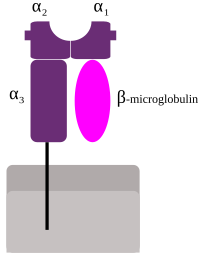
Photo from wikipedia
Human leukocyte antigen (HLA)-G, a non-classical HLA-class I molecule, has a low polymorphism frequency, restricted tissue distribution and immunoinhibitory property. HLA-G expression in tumor cells and cells chronically infected with… Click to show full abstract
Human leukocyte antigen (HLA)-G, a non-classical HLA-class I molecule, has a low polymorphism frequency, restricted tissue distribution and immunoinhibitory property. HLA-G expression in tumor cells and cells chronically infected with virus may enable them to escape from host immune surveillance. It is well-known that the HLA-G molecule is a novel biomarker and potential therapeutic target that is relevant in various types of cancers, but its role in cervical cancer has not been fully explored. In this review, we aim to summarize and discuss the immunologic role of the HLA-G molecule in the context of HPV infections and the process of cervical cancer carcinogenesis. A better understanding of the potential impact of HLA-G on the clinical course of persistent HPV infections, cervical epithelial cell transformation, tumor growth, recurrence and metastasis is needed to identify a novel diagnostic/prognostic biomarker for cervical cancer, which is critical for cervical cancer risk screening. In addition, it is also necessary to identify HLA-G-driven immune mechanisms involved in the interactions between host and virus to explore novel immunotherapy strategies that target HLA-G/immunoglobulin-like transcript (ILT) immune checkpoints.
Journal Title: Frontiers in Immunology
Year Published: 2020
Link to full text (if available)
Share on Social Media: Sign Up to like & get
recommendations!